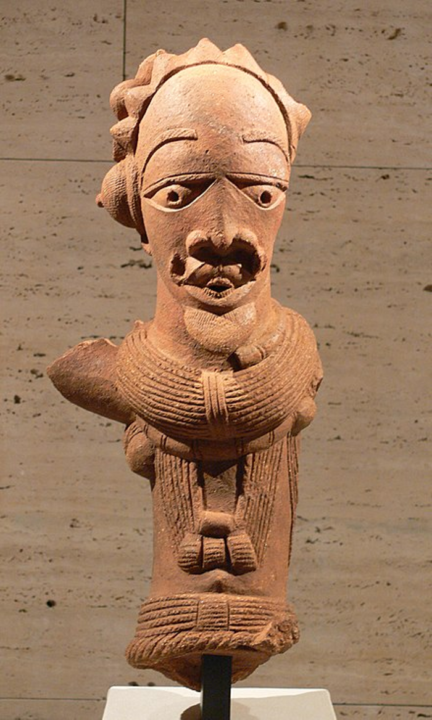Nok terracotta figure. Public domain
Nok culture, the archeological and cultural artifact of an African civilization that spanned from 500 BCE to 900 CE. The word Nok means “to make something” in the old Bamana language which is spoken by some hunters in Mali. The artifacts date back to 500 BCE, and are made up of terracotta sculptures, masks, and figures.
How Nok Culture Came to be
The Nok culture (or Nok civilization) is named after the Ham village of Nok in Kaduna State of Nigeria, where their terracotta sculptures were first discovered in 1928 by Colonel Dent Young. The terracotta was accidentally unearthed at a level of 24 feet (7 m) from an alluvial tin mine and the sculptures were presented to the Museum of the Department of Mines in Jos. Fifteen years later, a new series of clay figurines were discovered while mining tin.
The Nok culture is best known for its terracotta sculptures, which depict human and animal figures. These sculptures are thought to have been used as grave markers or for other ritual purposes. The Nok people were skilled metalworkers, and their art is characterized by its naturalistic style and use of iron.
The Nok people were able to create good-quality iron through smelting; this made them an important part of local trade networks as producers and smiths of iron tools, and likely made them fairly powerful.
The area covered by the Nok civilisation, over 2500 years ago, currently includes language groups such as Hausa, Jukun, Berom, Afizere, Amo, Anaguta, Aten, Bogghom, Buji, Jipal, Chip, Irchip, Fier, and over thirteen others.
The Nok culture disappeared around 500 AD, but its art has had a lasting impact on the world of African art. Today, the Nok style is still evident in the work of contemporary African artists.

(Image Source: en.wikipedia.org)

(Image Source: the234project.com)
Symbolism and Meaning in Nok Culture
The African Nok culture is one of the great wealth and notable artefacts. It is also full of inspirational symbolism that can be found in many different places. One of the most obvious places to find such symbolism is in the art that the Nok people create. Much of the art the Nok people created contains elements meant to represent different aspects of their culture and beliefs. For example, many Nok sculptures depict animals or people in positions that are meant to convey a certain message or meaning.
Symbolism is also found in their traditional ceremonies and rituals. These ceremonies often involve the use of specific objects or clothing that is symbolic of something important to the Nok people. For example, one ceremonial object that the Nok people use is a staff that is said to represent the authority of the chief. Another example is the use of feathers in some Nok ceremonies, which represent strength and power.
The presence of symbolism in Nok culture can be seen as a way for the people to communicate their values and beliefs to others. It can also be seen as a way for them to express their creativity and uniqueness. Whatever the reason, it is clear that symbolism plays an important role.

(Nok terracotta figure. Image Source: en.wikipedia.org)
The Role of the Women in Nok Culture
Nok culture is rich in artefacts and symbolism, with a particular focus on the role of women. Women in Nok culture are seen as the custodians of tradition and are responsible for passing on knowledge from one generation to the next. They play a vital role in ceremonies and rituals, and their status is reflected in the art that is produced by Nok artists.
Nok culture places a great deal of importance on the role of women, which is reflected in the art that is produced by Nok artists. Women are seen as the custodians of tradition and are responsible for passing on knowledge from one generation to the next. They play a vital role in ceremonies and rituals, and their status is reflected in the art that is produced by Nok artists.
Knowledge of Customary Law: A Tradition of Wisdom and Justice
The notion of law is an important concept in all cultures. In the African Nok culture, customary law is a tradition that has been passed down through the generations. This system of law is based on the collective wisdom and experience of the community. It is not a written code, but rather a set of customs and traditions that have been followed for many years. Customary law is an integral part of the Nok culture and helps to maintain order and justice within society.
Source:
https://en.wikipedia.org/wiki/Nok_culture
https://en.wikipedia.org/wiki/Nok_culture#Discovery

Victoria Ezechukwu-Nwagwu is a dynamic communications professional and the Executive Assistant to the Publisher of FunTimes Magazine. she brings a strong foundation in media, strategic communication, and organizational leadership.
Victoria is passionate about continuous learning and driving creative innovations that enhance engagement and impact. Her dedication to excellence and keen eye for detail make her an invaluable asset in fostering collaboration and executing high-level initiatives.





